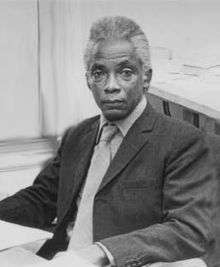Denis Williams
Denis Williams (1 February 1923 – 28 June 1998)[1] was a Guyanese painter, author and archaeologist.
Denis Williams | |
|---|---|
 Denis Williams | |
| Born | Denis Joseph Ivan Williams February 1, 1923 Georgetown, Guyana |
| Died | 28 June 1998 (aged 75) |
| Occupation | Author, painter, archeologist |
| Nationality | Guyanese |
Biography
Dr. Denis Joseph Ivan Williams, C.C.H., Hon. D. Lit., M.A., called by his friends "Sonny" Williams, was born in Georgetown, Guyana,[2] where he received his early education; he was granted a Cambridge Junior School Certificate in 1940 and a Cambridge Senior School Certificate in 1941. His promise as a painter won him a two-year British Council Scholarship to the Camberwell School of Art in London in 1946. He lived in London for the next 10 years, during which he taught fine art and held several one-man shows of his work as well as producing the artwork for Bajan novelist George Lamming's first book In the Castle of my Skin.
From 1957 to 1967 he taught art and art history at the School of Fine Art, Khartoum, Sudan; the University of Ife, Nigeria; Makerere University, Uganda; and the University of Lagos, Nigeria. He also published numerous articles on the history and iconography of West African classical art expressed especially in brass, bronze, and iron, and a book, Icon and Image: A Study of Sacred and Secular Forms of African Classical Art (1974, New York University Press).
Williams had been exposed to archaeology in Sudan and renewed his interest in 1968 when he finally returned to Guyana and established a homestead in the Mazaruni District. In his first letter to the Smithsonian Institution in 1973, he said: "my interest in these antiquities is that they may explain something about the who and how, as well as the when of the arts of the Guyana Indians."[3] His appointment in 1974 as director of the newly created Walter Roth Museum of Anthropology in Georgetown provided the opportunity to pursue this quest. Initially, he concentrated his attention on petroglyphs, not only recording the designs, but excavating to recover the tools used and observing the environmental contexts. His Master's thesis, The Aishalton Petroglyph Complex in the Prehistory of the Rupununi Savannas, submitted to the University of Guyana in 1979, presented ideas elaborated in a 1985 article published in the journal Advances in World Archaeology.
In 1980 he began intensive archaeological and paleoclimatic investigations of the shell middens on the northwest coast of Guyana. From the beginning of his studies, he was aware of potential disturbance of stratigraphy, errors in radiocarbon dates, and other pitfalls, and some of his efforts to detect them were detailed in Early Pottery on the Amazon: A Correction.[4]
Evidence for a correlation between the declining productivity of mangrove resources and changes in artefacts and settlement behaviour was summarised in Some Subsistence Implications of Holocene Climatic Change in Northwestern Guyana.[5] His observation that the methods employed by the Warao for processing palm starch are preadapted for eliminating the poison from bitter manioc offers a reasonable explanation for the origin of this remarkable technology.[6] A monograph detailing his evidence and interpretations of the interaction between environmental change and Guyana prehistory was in press at the time of his death.
He recognised the importance of publication and in 1978 founded Archaeology and Anthropology, the journal of the Walter Roth Museum of Anthropology in Georgetown. Among other journals Williams edited were Odu (the University of Ife Journal of African studies) and Lagos Notes and Records, and he contributed numerous essays on art to several books and journals. His skill as a writer is documented not only in his scientific papers, but in numerous works of fiction.
In 1986 Williams and his assistant, Jennifer Wishart, initiated a programme for junior archaeologists in Guyanese secondary schools.
Awards
His accomplishments were recognised in several national awards, including the Golden Arrow of Achievement Award from the government of Guyana in 1973, and the Cacique Crown of Honour in 1989, the same year that he received an honorary doctorate from the University of the West Indies.[1]
Selected works
Other Leopards (1963; reprinted Peepal Tree Press, 2009)
Prehistoric Guyana (2003)
Pages in Guyanese Prehistory (1995)
Habitat and Culture in Ancient Guyana (1984)
Contemporary Art in Guyana (1976)
Guyana, Colonial Art to Revolutionary Art, 1966–1976
Icon and Image: A Study of Sacred and Secular Forms of African Classical Art (1974)
Giglioli in Guyana, 1922–1972 (1973)
Image and Idea in the Arts of Guyana (1969)
The Third Temptation (1968; Peepal Tree Press, 2010)
Further reading
- Charlotte Williams and Evelyn A. Williams (eds), Denis Williams, a Life in Works: New and Collected Essays, Editions Rodopi B.V., 2010.
- Victor J. Ramraj, "Denis Williams (1923–)", in Daryl Cumber Dance, Fifty Caribbean Writers: A Bio-Bibliographical Critical Sourcebook, Westport, CT: Greenwood, 1986, pp. 483–92.
References
- Petamber Persaud, "The Life and Work of Denis Williams (1923–1998)| The Shaping of Guyanese Literature", Guyana Times International, 23 November 2012.
- Author information at Peepal Tree Press.
- Betty J. Meggers, "Denis J. I. Williams, 1923-1998", Journal for the Society for American Archaeology, 17.4 (September 1999).
- 1997, American Antiquity 62: 342.
- 1982, Archaeology and Anthropology.
- 1992, "El Arcaico en el Noroeste de Guyana y los Comienzos de la Horticultura". In B. J. Meggers (ed.), Prehistoria Sudamericana, pp. 233–51.